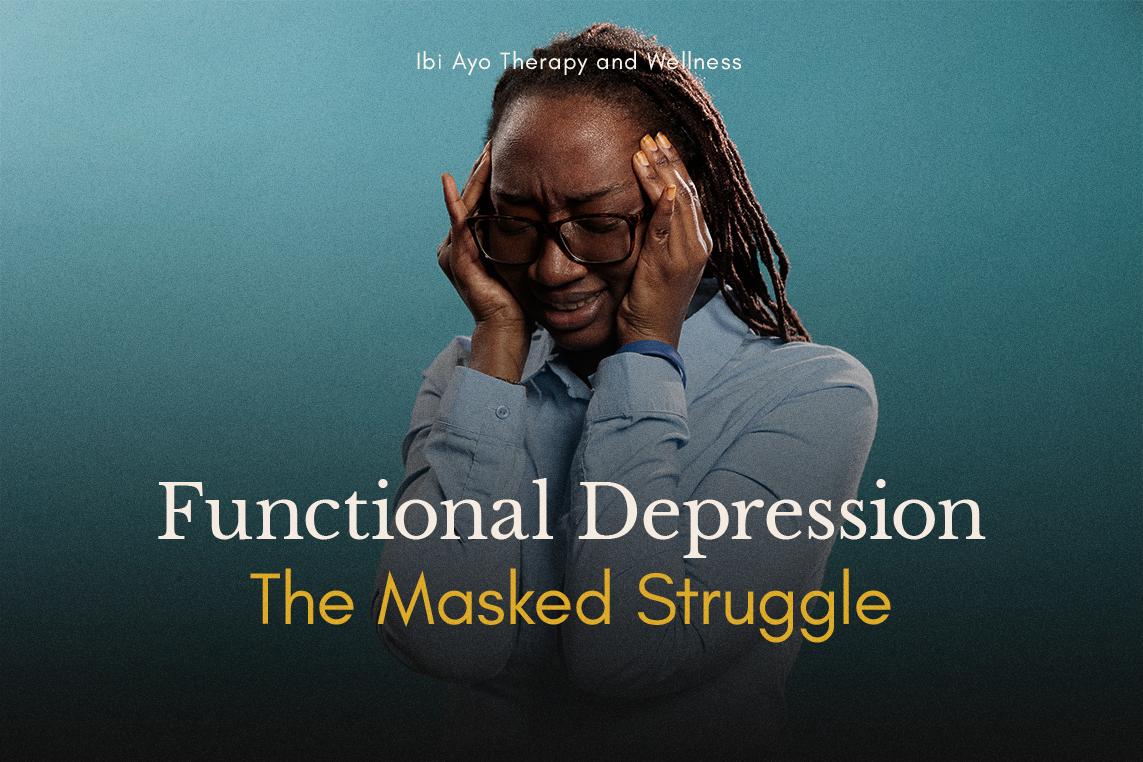Functional Depression: The Masked Struggle
When we talk about depression, we often picture overwhelming sadness, withdrawal, or a visible loss of interest in daily life. However, depression doesn’t always appear this way. For many people, it shows up quietly, hidden beneath productivity, a polished appearance, or a reassuring smile. This experience is commonly described as functional depression
What Is Functional Depression?
Functional depression describes a pattern where someone is able to meet their responsibilities, going to work, caring for family, showing up for others while privately struggling with emotional pain.
On the outside, they seem “fine.” On the inside, they are hiding their true emotions and struggles from the world. This can make it difficult for others to recognize that they are struggling, and even harder for them to seek help.
Symptoms of Functional Depression
The symptoms of functional depression can be subtle and varied. Some common signs include:
Feeling empty or hollow inside, despite appearing happy and fulfilled on the outside
Difficulty sleeping or experiencing changes in appetite
Physical symptoms such as headaches, stomach problems, or muscle tension
Feeling disconnected from others, even when surrounded by friends and family
Engaging in self-destructive behaviors, such as substance abuse or reckless spending
Feeling like you're "just going through the motions" of daily life
Examples of Functional Depression
Functional depression can affect anyone, regardless of their background or circumstances. Here are a few examples:
The High-Functioning Professional: Tosin is a successful businesswoman who appears to have it all together. She's always impeccably dressed, attends all the right networking events, and seems to effortlessly juggle her work and personal life. However, behind closed doors, Tosin is struggling with feelings of emptiness and disconnection. She feels like she's just pretending to be someone she's not, and the pressure to maintain this facade is taking a toll on her mental health.
The Busy Parent: Emeka is a devoted father of two who always puts his family first. He coaches his kids' sports teams, attends PTA meetings, and works hard to provide for his family's needs. However, despite his busy schedule, Emeka feels unfulfilled and disconnected from his loved ones. He struggles with feelings of anxiety and sadness, but feels like he can't show these emotions because he needs to be strong for his family.
The Social Media Star: Laura is a popular social media influencer who seems to have the perfect life. She posts pictures of her exotic vacations, her trendy outfits, and her delicious home-cooked meals. However, despite her online fame, Laura feels lonely and disconnected from the world. She struggles with feelings of inadequacy and low self-esteem, and feels like she's living a lie.
Treatment Options for Functional Depression
If you or someone you know is struggling with functional depression, there is hope for healing and recovery. Here are some treatment options to consider:
Therapy: Working with a therapist can help you identify the underlying causes of your functional depression and develop coping strategies to manage your symptoms.
Medication: In some cases, medication may be necessary to help manage symptoms of depression. However, medication should always be used in conjunction with therapy and other forms of support.
Support Groups: Joining a support group can provide a sense of community and connection with others who are struggling with similar issues.
Self-Care: Practicing self-care is essential for managing functional depression. This can include activities such as exercise, meditation, and spending time in nature.
Know your own boundaries and assertively communicate them. You can love your family deeply and still choose distance for yourself.
Final Thoughts
Functional depression is a complex and often misunderstood condition that can affect anyone. By recognizing the signs and symptoms of functional depression, we can begin to break down the stigma surrounding mental illness and encourage those who are struggling to seek help. Remember, you don't have to suffer in silence. There is hope for healing and recovery, and there are people who care about you and want to support you on your journey.
References
American Psychiatric Association. (2013). Diagnostic and statistical manual of mental disorders (5th ed.). Arlington, VA: American Psychiatric Publishing.
Hirschfeld, R. M. (2001). The epidemiology of depressive disorders. Journal of Clinical Psychiatry, 62(6), 4-10.
Kessler, R. C., Berglund, P., Demler, O., Jin, R., Merikangas, K. R., & Walters, E. E. (2005). Lifetime prevalence and age-of-onset distributions of DSM-IV disorders in the National Comorbidity Survey Replication. Archives of General Psychiatry, 62(6), 593-602.
Trivedi, M. H., Rush, A. J., Wisniewski, S. R., Nierenberg, A. A., Warden, D., Ritz, L., ... & Shores-Wilson, K. (2006). Evaluation of outcomes with citalopram for depression using measurement-based care in STAR*D: implications for clinical practice. American Journal of Psychiatry, 163(1), 28-40.
Learn the subtle signs of functional depression and how therapy, community, and self-care support healing. You don’t have to navigate this alone.

